
United Award Routing Rules: Intro
This site has been the first to publish many of the routing rules for United. And in many ways, it’s the only site to make any attempt to write about the subject. This is because the rules are not published by United itself, and many of the details of United’s routing rules were actually discovered myself.
Last year, I took the first crack on the internet for explaining United’s stopover rules, and went into details regarding how United restricts flights via regions to set up the post. I continued to write about segment rules, United’s errors and the like, but I realized that it was never in one place… until today.
The goal is for this to be the most comprehensive writing on United’s routing rules that exists, in blogs, forums or United.
Here is a summary of the rules you’ll find in this guide:

1.) United’s Region based rules
2.) Stopovers & Open-Jaws
3.) Connections
4.) Booking Errors


This guide is about the routing rules for award tickets. When using cash, the rules may be quite different, especially in outcome. If you add a stopover to a paid ticket, it may increase the price. With an award ticket, a stopover will not increase the price, ever. I should be honest and note that I don’t really have much experience with booking paid tickets. Despite all our travels, I have only booked a couple tickets that were paid tickets that weren’t tiny flights on discount airlines like RyanAir or AirAsia. So if you’re looking for those rules, they aren’t here or on this site really. This site is about using miles.
Besides the issue of less availability for award tickets, the routing rules when using miles are much more generous. Although it’s important to understand your options, because you may be missing out on the generosity and the options your miles offer.

Note that the routing rules you’re about to read are not published online, but they are consistent formulas that I figured out and kept track of. Some of these things contradict what seems intuitive, what other bloggers say, and what United itself might say. But, I assure you that these have been tested and the readers here have tested them and found them to be rules. These are rules, not speculations. When you try to do a stopover in Africa on the way to Japan, the price will come out lower than a regular Africa ticket. When you try a stopover on an open-jaw or when you try to book too many segments, you will get an error.
Routes and Regions
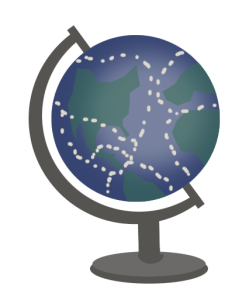
United does not limit routes by mileage flown, like AA, instead it solely determines how far or where you can fly based on what locations you want to include.
A trip to London for example, doesn’t prevent you from routing through other cities based on anything other than what region(s) you are flying to. It actually doesn’t matter if it’s London or Istanbul, it works the same.
A flight to London would be allowed to route through Istanbul, not because it’s on the way but because it’s part of the same zone.
In other words, it’s not about “being on the way”, or within mileage limits, it’s purely about what regions you’re allowed to touch. And here I’ll rehash what I wrote in United Routing Rule Secrets.
Europe and Oceania can’t be combined.
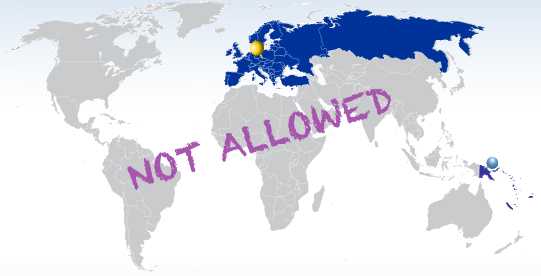
Africa and Australia can’t be combined.
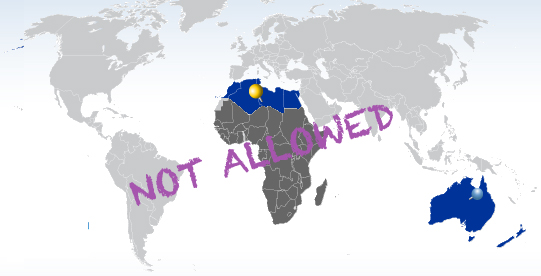
Europe and Australia can’t be combined.
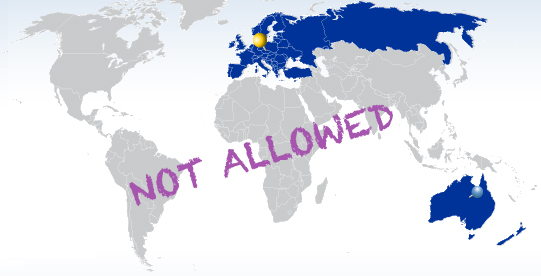
Africa and Oceania can’t be combined.
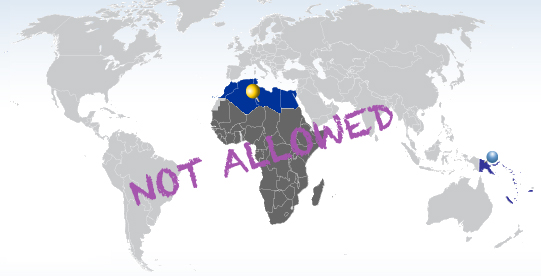
Middle East and Oceania can’t be combined.
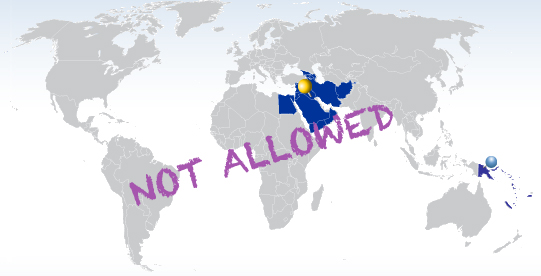
South America can only combine with…
North America, Central America, Mexico and the Caribbean. Brazil is an exception and can also combine with South Africa in addition.
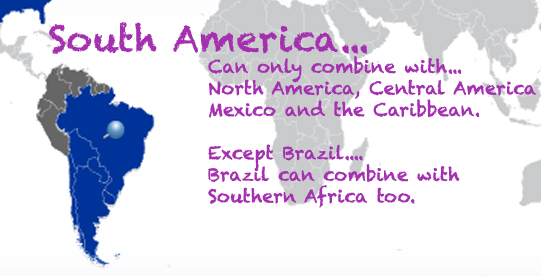
Most Powerful Zone Concept

However, prices aren’t always what you think they’ll be. If you touch two regions, you’ll find that the price the computer chooses isn’t always the higher priced region. Sometimes it touches a more expensive region and a cheaper region and still gives the lower price.
This is the concept behind: United Routing Rules and Stopover Secrets
I call the way it chooses the price a list of “powerful zones”. When two regions are touched (that are allowed to touch) the more powerful zone’s price is chosen.
Order of powerful zones:
What this means is that when you combine two regions (stopover + destination) on a roundtrip, the price you get will be the one higher up the list. If you stopover in Africa (80k) on your way to Japan (70k), Japan will be your destination as it will price out at 70,000 miles.
If you combine the Middle East (85k) will Northern Africa (80k), it will be a Northern Africa ticket and price out at 80,000.
Connections
In a post during some of United’s changes to routing rules in December, Kalendil commented sharing that what I speculated was true, that they are limiting tickets by segments.
Since then, there’s been a lot of confusion around the subject. People “realizing” that the rules have changed when they just haven’t realized a fundamental key to the connection rules. So I dug in deep and looked at every region for the connection limits.

Here they are…
From North America on roundtrip:
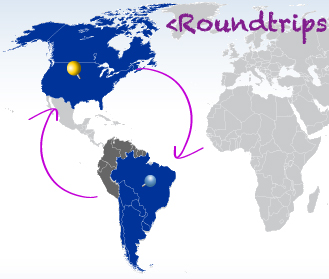
The thing that may have thrown a lot of people off or may have led them to believe that United recently changed their routing rules is probably that they checked a route searching oneways. If you’re looking into a route by searching oneways, many of the limits that are 4 connections on a roundtrip will now be 3 connections. This may explain why someone might see different rules every time they check the same region.
From North America on One-ways:
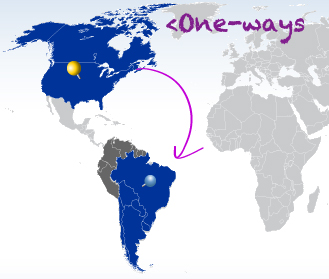
These are a few of the rules actually published on United.com. Which usually doesn’t mean much, but I went through and tested these and they seem fairly accurate. I couldn’t get more than 4 connections on a roundtrip to Bangkok and I could get 7 connections on a trip to Peru.
Example: If Bangkok is your destination and it’s a roundtrip, then you have 4 connections. This could include a stopover someplace, like Vienna. Your 4 connections must include the stopover on the way to Bangkok, you don’t get 4 connections to your stopover and to your destination and home. Just 4 connections each way to and from Bangkok.
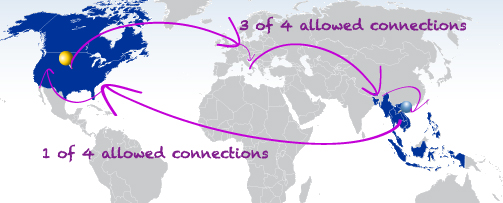
A quick search for flights from NYC to Vienna and Vienna to Bangkok showed this route: EWR – MUC – VIE (stopover) – FRA – BKK. That’s 3 connections including the stop in Vienna and is totally a legal route.
If you’re short on connections you may have to start from a hub, stopover in hubs, find days with more direct routes, or pick a destination with unlimited connections, like the Middle East.
Stopovers
You are allowed one stopover and two open-jaws on roundtrip tickets.

A stopover is essentially a second destination. Stopover in London for a week on your way to Paris for a week. As long as it follows the region routing rules, you’re allowed to stop anywhere in a valid region.
An open-jaw is when you continue your flight from a different airport and a part of the ticket where the airline isn’t responsible for your transportation.
For example, fly into London and out of Paris. It doesn’t matter if you drive, bus, walk, or bike to get to Paris, the airline gets you to London and takes you home from Paris. (And you get yourself from London to Paris.)
A layover is less than 24 hours. Anything more and it requires a stopover.
Where open-jaws can be placed:
In December I did a post speculating that United added more unpublished routing rules and said that it seemed that they no longer allow open-jaws on stopovers. Since then I have tested this thoroughly and found no real exceptions.
As I’ll explain later, it’s important to know which city is the stopover and which city is the destination. Therefore there are two valid examples of an an open-jaw and one invalid.
Invalid open-jaw: on a stopover.
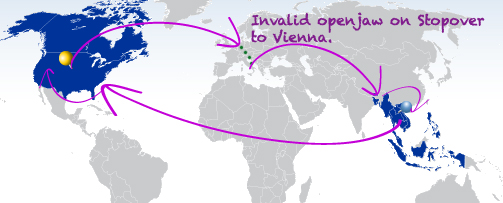
Valid open-jaw: on the destination or ending city.
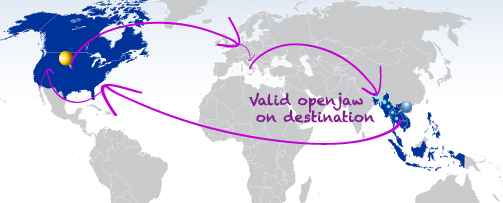
Exception: Hawaii…
Open-Jaws can be applied to a stopover when Hawaii is the stopover on the way to these destinations: SE Asia, North Asia, Japan, Central Asia, Australia, Oceania

To understand this, you have to understand that the stopover is not determined by you, but rather by the computer and its list of “powerful zones”. As mentioned earlier, a stopover is practically like a second destination. So the computer decides which of those destinations the stopover is based on which zone is less powerful or has less priority for pricing.
Here’s an example. While you can stopover in Vienna on the way to Japan, you will not be able to open-jaw and return from another city in Europe. Because Europe is a less powerful zone and therefore is the stopover, you would not be able to open-jaw and see Vienna and Rome on the way to Japan.
You would be able to open-jaw in Japan and see Kyoto as well. US to Vienna to Japan and then return from Kyoto to the US.
Another valid example would be return to a different city in the US than the one you started from. If you did NYC to Japan, and then did Japan to Los Angeles, that would be fine.
Although, again, the destination and stopover can be as long as you want, assuming that the ticket is still bookable. You could stop for 6 months, but know that airlines only sell tickets about a year in advance (give or take a month). You need to have your travel completed in a bookable timeframe, although it may be possible to extent your ticket.
Understanding connections further
These rules we’re discussing apply to your route to the destination and from your destination.
The key to all this, again, is knowing what is technically your destination. Your destination is not necessarily the furthest point or the point of turn around. Your destination is determined solely on the list of more powerful zones. The question is not what we think the destination is, but what United’s computer thinks it is. This affects many routing rules.
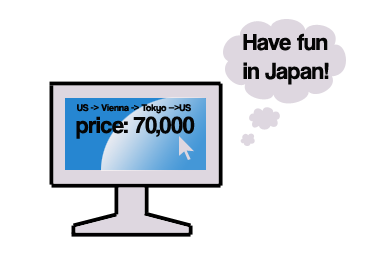
Another way to figure out your destination is based on the price of the ticket. If you’re flying to Europe to have a stopover in Vienna, and then continuing on to Tokyo, Japan and the roundtrip price (starting in North America) is 70,000 miles, then what’s the destination? Well, if it were just Europe the price would be 60,000 miles and if it were just Japan the price would be 70,000 miles. Therefore the 70,000 price indicates that it is a Japan ticket and Japan is the destination.
This is the easiest way to figure out what the destination is. Again, you can use the list of powerful zones or you can figure it out yourself using the award chart and seeing what the price would be.

It is important to pinpoint which city is the destination in order to figure out:
Let’s take a more extreme example. The example we’ll be using to show these is NYC – JNB (South Africa) – NRT (Japan) – NYC (USA)

You would think being a ticket to South Africa that it would price out at 80,000 miles, right? But instead it prices out as a Japan ticket for 70,000 miles. Because we know that Tokyo, Japan is the actual destination we can now know the follow things:
1) You can not have an open-jaw on the stopover. You therefore wouldn’t be allowed to open-jaw in South Africa but you could in Japan. You could fly into Tokyo and out of Kyoto.
2&3) You are allowed 4 connections to get to Asia and therefore you would count your connections from NYC to NRT, even though that would include JNB.
In other words, with this ticket you’ll need to be able to go from NYC to JNB to NRT in 4 connections. Then you’ll need to get from NRT to NYC in 4 connections.
4) This could work in two different ways – an open-jaw so you don’t continue from Tokyo, or an open-jaw so you don’t return to NYC.
If you don’t continue your flight from Tokyo and continue your flight from Hong Kong, you need to price one way NYC – NRT and then price out the second part from what is your second destination, Hong Kong; HKG – NYC.
NYC- NRT is 35,000 miles.
HKG – NYC is 40,000 miles.
The other way an open-jaw could change the price is if you returned to a different region. Say instead of ending your trip in NYC you end it in the Caribbean, like San Juan, Puerto Rico. You’d price out the same NYC to NRT and then price it out from NRT to SJU.
NYC – NRT is 35,000 miles
HKG – SJU is 45,000 miles
This is why it is so important to understand where the destination is. Imagine how confused you would be if you assumed that JNB would be your destination. You would try to figure out the connections incorrectly and demand an open-jaw.

If a stopover is in the same region as the destination, how do you determine which city will allow an open-jaw?
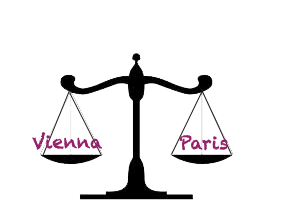
Don’t worry, United’s engine will determine that the stop without an open-jaw is the stopover. Take the stop in London on the way to Paris example. See if you open-jaw in the UK so you fly into London and out of Edinburgh and then fly to Paris, that could be a legal route because Paris could be the destination. It has nothing to do with which one is further, the point of turn around, or which direction you’re going.
But this can not be so with the South Africa example. If you added an open-jaw in South Africa it would have to be the destination. And if South Africa is your destination you can not stopover in a more powerful region on the way home like Japan. You would still be able to stop in a less-powerful region like Europe, but you wouldn’t be able to technically stopover in Japan without it becoming the destination and removing your ability to open-jaw in S.A.
But when it’s the same region, there is no issue of more or less powerful cities.
When you get the error message…
Recently we did a post detailing the various reasons a person may come across the error message when trying to book a ticket. Though that post was pretty recent, we decided to include it to keep this complete guide…complete.
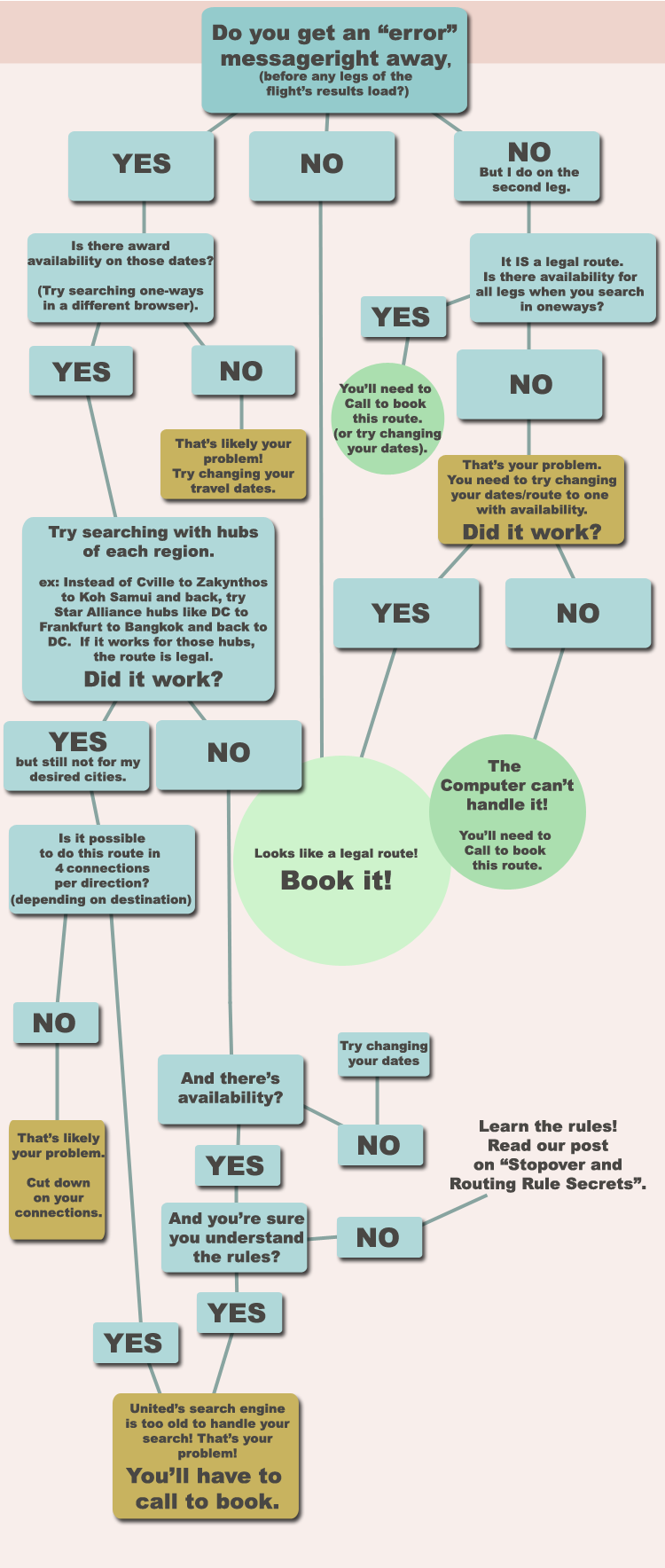
Next time you get an error message, try to follow this chart to see if it’s the computer’s fault, or if you need to go over these rules again! If it is for sure a legal route and it still won’t let you book online, just call.
Conclusion
Because there is so much opportunity for using stopovers well with United, and because they don’t pass on fuel surcharges, United MileagePlus miles are still probably my favorite miles to collect and use. AA (and US Air) miles also don’t pass on fuel surcharges and have better prices, but there are some phenomenal redemptions possible with United miles.
Of course, if you are a first class only kind of person, United’s prices may be quite high. But if you’re looking to get the most out of your miles, knowing the routing rules can be super helpful. Actually, if you’re doing anything besides a regular ticket, knowing the routing rules helps. Too many people have duked out losing battles with phone agents, not realizing the computer decides basically everything. The key is knowing what the computer does.
I hope United miles routing rules aren’t a mystery any more.



![The [Only] United MileagePlus Award Chart](https://travelisfree.com/wp-content/uploads/2019/04/United-MileagePlus-United-Airlines-Award-Chart-120x86.jpg)
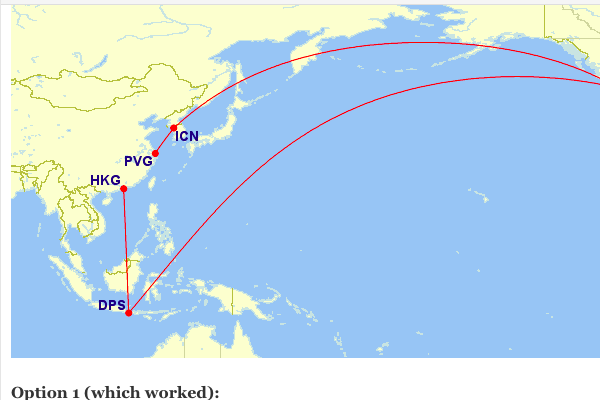

drew, is there any ways to search on your site for one of your old article ? I need to find the one on US Air routing rules. Thanks
There is a search bar on the right side. Second thing down, right below the newsletter sign up.
But I’ll save you the time and say that there are no US Airways routing rules. The allow one stopover or one open-jaw. Besides that it’s whatever an agent will book for ya.
This is a truly awesome post. Have y’all had much success (or heard of others) getting agents to allow US Airways award ticket stopovers within the same region? I thought that that was pretty much a rule. If allowed, their 30,000 South Asia RT in business class would be astonishing (and it is already the best value of any program, in my opinion).
My guess is that you understand this stuff better than anyone who works at United. Thanks for a most helpful post.
Someone had to code it. Although, it could have been multiple people’s work over time. :-p
I’d bet good money that it is a mess of spaghetti code held together with duct tape at this point.
Hi Drew,
Booked JFK -SYD-NAN-AKL-JFK was charge 75,000 each ticket … According to your chart it looks like it should be 70,000. Why am I paying 5,000 points more?
@Sara: Did you book a stopover in SYD?
Without knowing the specifics of your connections or stops, I would guess that it’s pricing as two one-ways: one from NA to Aus and one from Oceania to NA. Check to make sure you only have 1 stopover and 1 destination.
Can you give the specific route and where the stops are? Unless you’re doing an open-jaw from SYD to NAN, I can’t imagine how it would come to 75k tho.
you got a direct flight crom JFK to SYD? a direct flight from SYD to NAN?
I tried to book an award ticket that seems to be 100% in compliance with your rules, but the Premier ticketing agent said that the computer wouldn’t accept the routing. I’m wondering if you can tell me what the problem was:
SFO-LAX-SAL-GYE-GPS (Stopover) GPS-GYE-LIM-SCL (Destination/Open-Jaw) LIM-SAL-JFK
There should be unlimited connections allowed in South America, right? Was the computer perhaps trying to make GPS my destination (perhaps Northern South America is oddly a more powerful zone than Southern South America)? Or maybe I ran into trouble by going through Lima twice (not sure if that’s not allowed)? All of the flights had award seats available (as seen through several one-way searches), so I know it wasn’t that.
Thanks!
Lima twice, three times, it doesn’t matter. That’s fine.
And Northern SA beign a more powerful zone would be a good problem. I’m thinking either…
1) Did you actually find GYE-GPS availability on United.com. I’ve never seen that, but that would be a good fine. If you haven’t found that award space… that would be the problem.
2) Are you trying to fit in all the connections as long layovers? Like manually adding them? If so, that could cause United.com to freak out and show an error. Too much work for an old program. It may still be possible over the phone then.
1) Yeah, I found GYE-GPS availability (saver economy) through Avianca (AV1632 and AV1633). I’m a teacher, and I book my summer vacations 10-11 months in advance to maximize saver economy availability.
2) The connections are all layovers ranging between 1 and 8 hours. I’m not planning on leaving the airport for any of them or anything; I just had to accept such complicated routing because there’s nothing any more direct than that. FWIW, I did one-way searches for SFO – GPS, GPS – SCL, and LIM – JFK to check the availability (well, some of them were found via round-trip searches because for some odd reason more seats came up that way, but still…).
In the end, I booked the ticket as SFO-LAX-SAL-GYE-GPS (Stopover) GPS-GYE-LIM (Destination) LIM-SAL-JFK for 40,000 miles. I’m going to skip Santiago, and possibly just do a loop around Southern Peru, Western Bolivia, and Northern Chile overland. Either way, I’m thrilled to get to visit the Galapagos Islands with a stopover in Peru for only 40,000 miles, and $100.92 in taxes, so I’m not complaining by any means! I’m just curious about why the system wouldn’t let it happen, even when talking to an agent.
Are we sure there are unlimited connections allowed in South America? Because it didn’t allow a routing with 7 connections on the way to Santiago [SFO-LAX-SAL-GYE-GPS-GYE-LIM-SCL (Destination/Open-Jaw) LIM-SAL-JFK], but it did allow a routing with 4 connections on the way back from Galapagos [SFO-LAX-SAL-GYE (Destination?) GPS-GYE-LIM-SAL-JFK].
Or maybe there’s just a weird quirk happening!
Good user guide, Drew. Kudos again for your effort in producing great content.
Great post Drew! I always appreciate the amount of research and clarity you put into your posts.
Hi Drew,
My route:
Outbound: JFK -LAX -MEL ( transfer flight at LAX)
Then NAN-AKL
Then AKL-SYD-JFK (transfer flight at SYD)
Is my 1st time using miles after following your blog for 2 years! I went ahead and booked even tho I had to pay 5000miles.
But I don’t understand why I need to pay 5000miles more.
75000 is right, the outbound to melbourne is 40000 and the inbound is 35000
so if the outbound was to syd instead of mel it would be 70000? but i through it was priced for oceania….which is 70,000
Side note, I’m really curious how you’re getting from MEL to NAN??
So you have two destinations because you open-jawed the destination. You price to one, and from the other when there’s an open-jaw on the destination.
US – MEL = 40,000
NAN – US = 35,000
If you stopovered in MEL on the way to the destination, than it would be 70,000. But honestly, sounds cool if you get another stop. Congrats! It’s really a magical awesome place. And it’s a great redemption, just a lot of flying. 😀
Can’t believe it’s your first redemption. Hope there’s more to come.
I was planning to buy a one way ticket to Nadi…since I started following you I been wanting to do my redemption ..but knew that I was in the process of purchasing a home , I had to hold off on credit card sign up! Now I’m free to go! Lol….I have a list of credit card to sign up!!!! Can’t wait for more redemptions !
Thanks Drew for another great resource. Reminds me I wanted to get the United/Chase cc before 9/1, and glad to see you have a link to it via your credit/Karma link. (and thus, a small, tangible thank you)
+1. Happily applied through your link for my wife today and got approved. A small token of gratitude for all the excellent content you provide.
Wow guys. Just… I mean, thank you guys for your support. Support too in continuing to come to our site and comment and support us in those ways. Just, thanks…
Hi all,
Have anyone had success booking multiple long layovers going from NA to EU roundtrip? I keep on running into the 4 segments max each way. Should I continue to hang up and call again? Some even mention such practice as “abusing” the system. I was trying to have 3 consecutive long layovers in Europe.
I’ve heard of people in the comments here booking many long stopovers. I’m surprised they would call it abusive unless your backtracking or doing some absurd route. Then you just have to find a dumb agent. Sounds like you need to learn to sweet talk an agent, or how to feed them the info without them asking things.
I kind of say I have a series of flights written down. “US flight xxxx out of XXX (@ xx:xx am). Then LH flight xxxx on july 19th. Then OS flight XXX on July 20.” That kind of thing. I really don’t push it with layovers though.
Drew, I’ll be forever indebted to you for all your great United routing rule information! 🙂
A forever IOU. Does that mean I get to cash in as much as I want? Or does that mean I have to wait forever to cash in? :-p
I admire this post so much! Glad I found your blog and keep checking it everyday!
Can you provide more details about having stopover in Hawaii with an open-jaw here? If I fly in to HNL, do I have to fly out of one of the Hawaiian airports? Can I open-jaw to other region?
Hi. Sort of a rookie question here, but I’m trying to do CLE-LAX-TYO(stopover)-BKK-SYD, SYD-LAX-CLE in First. Does the fact that TYO-BKK-SYD is via a Star Alliance partner affect the price? If we just did CLE-LAX-SYD-LAX-CLE it’s 160,000 miles. Adding in the TYO stopover is adding 50,000 miles, putting me at 210,000 (searching on their site, at least), so I’m wondering if it’s the Star Alliance or I’m doing something else wrong. Thank you, and thank you for the great site and post!
Thanks for the awesome work, Drew & Caroline! If ever you were in town (SAN), I’d buy you lunch / dinner!
I tried testing the 4-max-connection rule and the open jaw rule on the destination… I tried putting in SAN-BKK-SYD (open)-AKL-SAN which doesn’t work even though SYD would be the destination (based on powerful regions) and connections would just be 4: SFO, TPE, BKK, SYD.
@travelisfree
why is this routing not legal please? (or is it?)
CLE-YYZ-PEK-MNL(stopover)-PEK(dest. & OJ), DME-FRA-IAD-CLE.
illegale because its a 3-region award?
thanks
This. Is. Awesome. Love what you’ve done and bookmarked for reference.
Hi Drew,
I just booked a ticket which seems to not adhere to the “powerful zone” concept. My route is:
JFK–FRA–BKK–KTM (in Nepal for a week)
KTM–BKK-RGN (in Burma for a week)
RGN–BKK–ARN–EWR (back home)
I was expecting it to cost 85,000 miles (since Central Asia, my stopover in Nepal, is the most powerful zone). But instead, I got charged only 80,000 miles (not complaining!). It seems the system used the common-sense “on-the-way” logic of my itinerary: Nepal was the stopover, and Burma was the final destination, hence I got the South Asia price of 80,000 miles.
Any idea why this might be? Could it have something to do with my return to EWR technically being an open jaw since I left from JFK? (Is that even true that that counts as an open jaw, when you return to a different airport in the same city?)
Thanks, love the blog!
Drew,
I just have a quick question. You mentioned Hawaii is an exception for the open-jaw as the stopover. So is the following itinerary legal?
11/1/2014 PEK – CLE
3/1/2015 CLE – HNL (spring break to Hawaii, only need a one-way ticket back to CLE)
5/1/2015 CAK – PEK (CAK is very close to CLE)
Thanks a lot!
I am HKG based and trying to figure this out:
Combining Oceania and NZ/Australia on a ticket, it prices it as 35,000 miles round trip when combining NZ/Australia and:
– RAR
– ROR
– SPN
– GUM
But it prices as 45,000 miles round trip when combining with:
– NAN
– PPT
(others I haven’t tried yet)
This doesn’t seem logical. If both PPT and RAR were 10k more, maybe they would further break down Oceania into east/west of the date boarder or something, or if PPT, RAR and NAN were 10k more, it would be all south of the equator. But that’s not the case as RAR works out to 35k with a stopover in AKL (ticketed to fly it next year).
Any ideas how I can get NAN or PPT to price the same way?
Sorry, just as I say this, I found a way to price HKG-PPT (via AKL), PPT-SYD and PER-HKG (via BKK) for 35,000. I guess open-jawing in Australia told the system this is my destination as opposed to stopping over in AKL.
I gave the following itinerary to united last night, they actual told me to call them back in a few hrs while they figured out pricing (after I was on hold for 1/2 hr). Never heard of that one.
I called back and they wanted to price it as 3 RT’s which made no sense at all. It wasn’t liking this routing through BKK but that was all I could find. UA.com didn’t give me anything, I found it searching aeroplan and ANA.
NRT-BKK-AKL-RAR (stopover)
RAR-AKL-NAN (destination)
NAN-AKL-PVG-KIX (or hell, anywhere in Japan)
Also when I checked the itinerary they had on hold it didn’t have the last segment back to Japan so I am thinking maybe the issue is really # of connections? Just confused since you have to continually go through AKL. I don’t even know if it’s possible to have a stopover in another Oceania area in the south Pacific since I can’t figure out how to get there in less than 3 connections. But if I did AKL as stop it seems to go up to 50k miles. Help? or HUCA a lot?
Also the problem is that there are no direct flights from Japan to AKL…or, are there? I actually was screwing around on UA.com and found the segment I want, NRT-AKL direct (which has been disappeared for 2015 as far as I can tell) in the middle of a first class saver ticket from PVG (1st)-NRT-AKL (econ). They say they can’t book it though.
I’m pretty sure the Hawaii routing rules have changed. Take a look at
HNL -> BKK
BKK -> NRT
NRT -> HNL
This is not pricing out at 50k rt, instead it is 70k
Drew, thank you for the post.
I am curious about this and wondering if I can setup a route originating from NA (like YYZ, or YUL, or even YVR), stopover in Europe, then have the destination in Asia. Then from Asia back to the originating city.
However, I am curious if the class on the first leg can be mixed btw coach and business. I am guessing that if it is even possible, the leg will be priced out as business rather than coach?
Example:
YVR-YYZ-CDG (coach) – stopover in Paris
CDG-PEK-SIN (business), with SIN as destination
SIN-YVR (via ICN or PEK or TPE or HND or NRT; in business)
If I read the rules correctly, the destination is SIN, with stopover in CDG, correct?
What I am not sure about is if I price the CDG to SIN leg in business, would the segment from YVR to CDG be priced in business as well?
Thanks Drew for this –
I’m trying to plan a round trip that starts in Europe (IST) in April ’15. My home airport is IAD and I’m looking for a destination to hit for a week or so between IST and IAD. Was wondering if can go to BKK or some other cool destination – I’ve never been to Asia. Conversely, I could use the stopover on my way back to Europe in Aug/Sept – but again, trying to visit someplace other than just Europe in economy? I am using United miles. Thanks all!
I’m way late to the party on this article, but it just became relevant to me so my interest has piqued. 🙂
Egypt is odd in that, so far as I know, it’s the only country that United puts in two different zones — it’s in “Northern Africa” and also in the “Middle East.” This makes plays a bit of havoc with the “most powerful zone” concept.
For instance:
ORD -> ADD -> ORD = 80k (expected)
ORD -> AMM -> ORD = 85k (expected)
But then:
ORD -> CAI -> ORD = 85k
Even though CAI is also in Northern Africa, which is “more powerful” than the Middle East, it charges the more expensive of the two possibilities. Okay, … good to know.
ORD -> CAI -> AMM -> ORD = 85k
Okay, CAI is still pricing out at the higher of its two possible prices (despite the other being “more powerful”), but at least it’s consistent.
But then:
ORD -> CAI -> ADD -> ORD = 80k
Wait, what? In the other examples, CAI chose to be in the more expensive of its two possible regions, but in this example it decides to price out at the Northern Africa price. Odd.
In any case, I’m looking to visit Egypt, Israel, and Jordan in the fall, so I’m looking for a way to leverage this concept. These “sweet spots” seem to occur when a region higher on the “power” list charges a lower price — but in the case of the Middle East, the only opportunities there would be a combination with North Asia or Japan … and that ain’t happening.
A combination United/Avios award seemed like it might have possibilities, flying into Europe on United and then “Aviosing” my way to the Middle East, but the closest viable European airports (IST and ATH by my reckoning) are just far enough away from CAI, AMM, and TLV that it’s almost not worth the trouble. (I guess Cyprus is part of Europe, but I don’t exactly call that “viable.”)
Anyway, you’ve got me thinking … any suggestions would be appreciated. Thanks.
Stumbled across your blog – while searching how to best utilize my travel awards accumulated via Chase Sapphire CC (450,000 flight miles) I’m a little overwhelmed at the volume of information, but eager to learn more. Husband recently sold his business and we have time to travel. He has his own Sapphire CC with 150k miles. We prefer Business or Class travel. Since the Chase program allows the purchase of award travel on a variety or airlines, which is the best for BC or FC? I don’t have an itinerary yet. Drew, you are obviously the award travel guru – your insight is appreciated
Thanks for the helpful post. Even though it’s quite old I thought I’d mention something I found today in case it helps anyone else who is confused; it’s not a 4 connection rule between zones it’s a 4 stops rule. Hence if you have a flight which puts down on the way to either your stopover or your destination, even though you don’t change planes, that will count against the 4.
@Drew Macomber
can you route to SE asia via africa on the outbound and via europe (with a stopover) on the return please? or will this trigger a 3-region award?
thanks
@drew Do you have experience with 24 hour layovers internationally, when it’s within the same region? I just tried on united.com to book a connection >4 hours on an award within the same region (Brazil, non-star partner Azul). No go; priced as 2 awards. The engine priced as one award when <4 hours. I'm pretty sure I've done this before, and that this was a secret devaluation somewhere along the line, but cannot remember.
Appears to be an edge case. Only intra-brazil is not technically “international” (one nation). Other carriers treat foreign (non-N. America) as international and allow <24 hours inside same country (e.g., DL on G3). No idea how long this has been the case. Most layovers people use abroad span countries or are unlocked by a later part of the flight that does.
OK – Nevermind, sorry to bother! Looks like the engine booked it that way consistently, but a phone agent could ring it up as 12.5k
I had a question regarding the most powerful zones list. Where does the U.S. fall for travel originating and ending outside the US? I’m looking at an itinerary of DBX-SFO (stopover)-NRT (open jaw) KIX-MCT. I assume the destination is Japan (and thus the price would be 70k) unless the US is higher on the powerful zones.
Sorry, DXB (Dubai) not DBX
What an article! Thanks.
Hi – very comprehensive article – thank you!
I am just wondering if I am understanding the article correctly, or perhaps the article is out of date.
I priced SFO to SIN, via a connection in NRT in economy and it came to 80K miles roundtrip.
http://imagebin.ca/v/1wsBZ9atk8XB
I had expected that since the Japan zone (70k) is more powerful than the South East Asia zone (80k) it would have priced as the Japan zone.
Please let me know..
Thanks,
Tim.
Hello Drew, I really love this post which gives very detailed information about UA routing rules. I do see that most of them are US-based, but just now I tried to book a trip for HKG(origin)-BKK(stopover)-SYD and back for MEL-BKK(transfer)-HKG on united.com, I got error. Would you like to give me some advice on this route? Thanks.
Hi Kira,
I’ve been trying to book a similar trip, but originating & terminating in Seoul (ICN). I actually tried all kinds of combinations to get to Sydney. Nothing is panning out yet. You trying to fly United metal because of the open jaw? According to this map, United doesn’t fly HKG-BKK, though I could’ve sworn I flew that leg two years ago. (http://www.united.com/CMS/Documents/pdfs/route-maps/UAL_WORLD_Map_2015_04_01.pdf)
I am going to try Singapore instead of BKK as UA flies to Singapore. Singapore Airlines doesn’t show availability on United.com though…
Wow, I never found a map like that. UA does not fly HKG to BKK but Thai does. HKG and BKK both belong to South Asia and I would like to fly HKG to SYD roundtrip and set BKK as a stopover. Do not know which rule I violated coz I see the system error at very first.
Hey, Drew, would you please help me, I need to go to Phillipines and I want to see Italy on the to Manila and I live in Dallas . Would you please outlined me an example of possible iteneraries. I would surely appreciate it. Thank you
Dallas to anywhere in Italy, to Manila to Dallas would work fine.
Looks like North Asia can’t be combined with Europe AND South Asia; I couldn’t price out PEK>SIN>TYO>FRA>LAX. I’d imagine PEK>TYO>FRA>LAX to work; or PEK>SIN>FRA>LAX to work, but you can’t touch both regions.
For the regions that can’t be combined does that include connections? For example you can do North America – Middle East – Australia, but if that included a < 24 hr connection like North America – Europe – Middle East – Australia then it wouldn't work, correct?
Such a comprehensive yet easy to digest. From a first time visitor, thanks for putting this together!
What are they, how do they differ from stopovers, and why should I care?
Fail question; I meant to ask,
What are “connections”,
How do they differ from “stopovers”, and
why should I care?
:-p
Connection just means anytime you don’t get a direct flight. So if you connect in Germany to catch another flight to South Africa, that’s 1 connection. You’re sometimes limited in number of connections.
Of the connections some are layovers (under 24 hours) and some are stopovers (more than 24 hours). You get 1 stopover per roundtrip.
excellent answer! Thank you!
Here’s the deal: I want to go from SFO to JNB and back, stopping in EBB (Kampala, Uganda) en route to JNB and CAI (Cairo, Egypt) en route from.
1. Can I do that with two one-way trips (in case I don’t have enough miles for a RT)?
2. Can I have two stopovers on a RT, or just one?
There’s a good post on United Routing Rules, but I can’t remember where it is… hmm… Anyways. If I could find it, it would probably have this info:
I tried to use united miles to book SFO-DLC-SFO round trip and add a free one way SFO-OGG. But it always shows error. Is this legal? Can I call united to book it? Thanks!
Thank you so much for all the helpful information! Could you kindly address this question: Is it possible to obtain an award ticket from Europe to Hawaii, where the travel is in an Easterly direction (e.g., FRA->TYO/PEK/ICN->HNL)? Many thanks.
Hey Drew-
For us smaller-time domestic travellers 🙁 can you share an example how to maximize a stopover itinerary going from NYC to either SFO/SEA/PDX with a stop in say ORD or DFW?
I have a question regarding UNITED award miles from US to North Asia with partners metal. Would it be charged with partner award chart rather than UA’s one? i.e. 80k in F (UA’s chart) vs. 120k in F (star allaince chart). thank you so much!
Is a stopover in Europe allowed on an Australia to Middle East round trip?
Hi Drew,
I’m trying to book the following itinerary to Columbia, but United doesn’t ticket the itinerary.
SFO-SAL-BOG-CTY
CTY-PTY-LAS-SFO(stopover)-YVR(destination/open jaw)
When I take away the Vancouver leg of it, the ticket prices for saver 40k miles. Do you have any idea why the itinerary with the last open jaw would ticket would not price?
thanks!
Hey Drew,
Awesome post.
Do you have any info on whether or not there is a maximum number of connections between Europe and northern South America ?
Thanks
Apparently no according to what he wrote above but maybe something changed – “The following regions have limits on connections (4 connections on roundtrips, and 3 connections on oneways): Australia, Oceania, Japan,SE Asia, North Asia, and Central Asia. Every other region has no limit to connections.”
@Drew
anyway to route USA-caribbean-europe-USA for less than 95k per person please?
thanks!
Drew,
Thank you for this invaluable resource. I am planning a RTW trip with my family and am trying to maximize our miles use. This is by far the best resource I’ve found yet.
One probably very basic question: I am looking at a trip on united.com that seems like it follows the rules: IAH- GRU (stopover)- CPT- JNB (open jaw at destination)-JFK (open jaw at return destination). If I price the trip as three separate 1-ways (IAH-GRU, GRU-CPT, JNB-JFK), the most “expensive” of these is 47.5k miles. But if I price it using multiple destinations on the engine, it prices at 120k.
Any thought on what I’m doing wrong?
Many thanks!
It appears what he wrote above explains why it doesn’t work although I’ve never tried. “South America can only combine with…North America, Central America, Mexico and the Caribbean. Brazil is an exception and can also combine with South Africa in addition.”
Drew, i try to book to Europe next summer on UNITED. IAD – ATH – FCO then CDG to IAD. One stopover and one open jaw. It does not work. Am I doing anything wrong? Please advise
Did you try searching segment by segment?
wow, that was intense. Planning a trip to Australia and this really opens a few possibilities. thanks for the write up!
First of all, thanks a lot Drew for this great post! It really explains some of the weird pricings happening at UA for awards!
However, I still have a problem which I can’t get my head around …
I’m working on an award from South Asia (Cambodia) via North Asia (Seoul, South Korea) to New Zealand. Specifically I’m hoping/looking for something like REP-ICN-BKK-AKL.
Unfortunately the search from city to city doesn’t come up with a result and when I do a Multi-City Search, it keeps on pricing every segment by itself and only adds up the individual values. Obviously this leads to a totally overpriced award in the end.
Am I doing something wrong or is this a problem of the website?
I would be very grateful for any input and advise 🙂
Hi Drew! great article – you really are the only person that has united figured out this well! im trying to book multi-city (PHX-NRT-BKK-PHX) then i changed to openjaw (PHX-NRT & BKK-PHX). when i switched to searching the openjaw the points required almost doubled 🙁
PHX-NRT (20k) NRT-BKK (65k) BKK-PHX (65k) so to avoid 65k on NRT to BKK when i can just pay $350to fly thai, I researched the openjaw: PHX-NRT (35k) BKK-PHX (110k).
since the availability is there at the lower points redemption, do u think if i call they will let me book at the lower rate?
thanks!!
Thanks for this article. I think I may have run into another exception… I was trying to fly DEL-NRT-HNL-EWR but the computer won’t price it. The agent said that you can’t route from India to the US via the Hawaii zone, although this is after 4 or 5 other nonsense explanations by other agents. Does that sound right? Or should this itinerary be valid?
Hello Drew, could you please clarify routing rule with stopover in other region?
Simple example KUL-HKG-SIN, everything it within South Asia, right? So according to United’s routing rules it should be 60K for round trip saver with Star Alliance partners in business.
But if I decide to put IST as a stopover then KUL-IST-HKG-SIN is prices as 110K miles in Economy.
Have rules changed or am I missing something?
I priced from ORD-GUM-SYD-ORD and it is coming out to be 80k. According to the rules you mentioned above it should come out to be 70k. Have rules changed or am I missing something? Thanks.
Can you explain if AA also similarly allows unlimited connections on awards to Europe in the same way that United does?
I’m pretty sure that the SE Asia zone is now more powerful than the Japan zone… I got super-confused recently trying to book a R/T award from the US to Japan with an open jaw in Japan and a stopover on the return in Bangkok. First, the agent said that the open jaw in Japan was invalid (hmmmm), then that it priced out to 160k miles rather than the expected 150k. Now I realize that Bangkok (SE Asia) was the destination, from UA’s perspective, and Japan was the stopover. I now need to go back and maybe add an open jaw to Bangkok (maybe Phuket would be a nice diversion…). Side note: I get from the US to Bangkok in 5 flight segments (LGA-YYZ-YVR-ICN-NRT/HND-BKK). Is that really 4 ‘connections’? For some reason I though the limit was on flights (4 in each direction on a round trip).
Firstly, let me say that this post is extremely comprehensive and helpful. I’m still not clear though on the limitations of stop-overs, especially between two regions. For example, would I be able to fly NYC–> BKK–>NYC–> HKG? In this case, the first flight would be NYC–>BKK, and then the second flight wouldbe BKK–>HKG, with a stop-over on NYC. I know that it sounds ridiculous, but I don’t see what rules are being broken. I’m not combining any of the prohibited regions. If it is allowed, how many points would it cost?
Hey
I stumbled across this while working on planning my honeymoon. I keep getting conflicting info about the validity of this trip
NYC-FCO (stopover open jaw) Munich- JNB (destination) – NYC
Some talk of flying hone from Cape Town but will prob just fly from JNB.
Is thus legal routing? If not how could I make it legal? Thanks!
Thank you for your awesome information. I wanted to see if you got the same results i did (just to confirm I understand it!) So here is the itinerary:
IAH TO BOM
BOM TO MLE
BOM TO IAH
I figured we would just take a cheap flight from MLE back to BOM to save the points? It’s coming up with 127.5K miles per ticket. Does that sound right?
I just got a rewards ticket from Toronto to china and back. My trip home has a 4 hr layover in Paris. Can I call the airline and see if they can extend my layover for 24 hrs and return the next day? Will they count that as a stopover?
I have a roundtrip ticket from San Diego to Rome. The returning connection from Chicago to San Diego includes a 6+ hour layover at ORD. Tried to cancel that leg and find more convenient flight on other carrier from ORD to LAX. UA wanted to charge me 35,000 miles to cancel this leg. Funny, that not using their service costs miles.
If I simply no-show for that flight, can they charge me mileage penalty?
Thanks for this site info. CHEERS.
Hi– I am trying to book a saver award ticket for travel within south america. The saver award should be 20,000 miles roundtrip for southern south american, based on United’s award chart. Has anyone had success booking open jaw and stopovers on the inter-south america ticket? I am trying to book CTG–>MDE; MDE–>LIM; LIM–>CUZ or LIM–>IQT. When I search for each of these one legs individually, I get saver awards for 10K, so I could combine two of the one way awards for 20K total. However, I am trying to use United’s open jaw and stopover rules to get all three for 20K. But when I plug them into the search engine, my search says it doesn’t yield any results. If I call, will the representative be able to book this ticket for me for 20K?